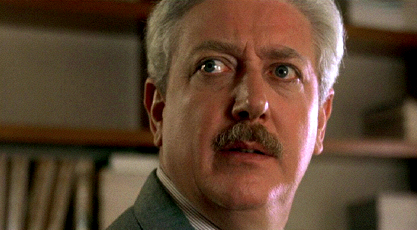Director: John “Bud” Cardos
Writers: Stephen Lodge, Jeffrey M. Sneller, Alan Caillou, Richard Robinson
Producer: Igo Kantor, Jeffrey M. Sneller
Cast: William Shatner, Tiffany Bolling, Lieux Dressler, Woody Strode, Altovise Davis, David McLean, Marcy Lafferty, Natasha Ryan, Joe Ross, Adele Malis-Morey, Roy Engel, Hoke Howell, Whitey Hughes, Bill Coontz (as Bill Foster), Jay Lawrence, Bettie Bolling, Anita Merritt (as Juanita Merritt), Nadia Caillou, Valla Rae McDade, Jon-Jon, Spec O’Donnell
In Verde Valley, Arizona, spiders are killing cattle and pets with their venomous bites. The local veterinarian Robert “Rack” Hansen (William Shatner) and entomologist Diane Ashley (Tiffany Bolling) are trying to discover the reason for these attacks and to advise the local authorities. Before long humans also become victims, and soon the whole town of Camp Verde is threatened by the evermore-aggressive multitude of deadly spiders.
The Flashback Fanatic movie review
In the nature-attacks film wave of the 1970s, spiders were a natural choice of threat as most people are not very fond of the eight-legged critters. They were members in a multi-species, man-killing army of the Florida bayou in Frogs (1972) and came from outer space to menace North Central Wisconsin in The Giant Spider Invasion (1975). When Stephen Lodge and Jeffrey M. Sneller, the writers of the original story for Kingdom of the Spiders, decided to base a horror film on what they were both afraid of, spiders were their mutual choice.
This film falls squarely into the eco-horror category. It is suggested that man’s pesticides have killed off much of the spiders’ natural prey. Therefore, the spiders have adapted to become more venomous and attack larger animals, including man.
William Shatner tops the cast in his best role since Captain James T. Kirk of the Star Trek TV series (1966-69). As veterinarian “Rack” Hansen, Shatner is down-to-earth, heroic, funny, and likable. His performance really distinguishes what could otherwise have seemed like just one more killer critter flick for the drive-ins. Of course, Shatner brings some star power to the production, but he also keeps things interesting between all of the horror stuff.
Shatner’s character and performance take the edge off of the boy-meets-girl movie cliché of the heroine playing hard to get. It is immediately established that there is a bit of a class and culture clash between Shatner’s desert town, pickup truck driving vet “Rack” Hansen and the liberated, Mercedes driving, university entomologist Diane Ashley (Tiffany Bolling). It makes some sense that, initially, there would be a bit of friction between the two characters. Hansen’s teasing of Ashley is amusing as are her rebuffs of his early advances. We learn to like these two characters and welcome their eventual comfort with each other.
This film demonstrates just how labor-intensive it must have been to make such a movie in those pre-CGI days. The filmmakers had to get thousands of live tarantulas onto the shooting locations, let them loose just before the cameras would start rolling, then round the spiders up again after each shot and put them into separate plastic cups so that they would not cannibalize each other.
Just as impressive is an airplane stunt that seems to occur quite close to our stars William Shatner and Tiffany Bolling. This all had to take place physically in front of the camera and must have required a lot of planning and precise timing to pull off safely.
Kingdom of the Spiders is a ’70s spin on that 1955 sci-fi horror classic Tarantula. Of course, in ’55, we also had a spider as the beastie, a desert setting, and the handsome local doctor hooking up with the beautiful visiting science academic. The science that got out of hand to cause the arachnid menace was also concerned with providing man’s food. In the atomic age of the ’50s, it was a scientist using radiation to develop a nutrient that caused a spider escaping from the lab to become a giant, man-eating monster. In Kingdom of the Spiders, the man-made cause of the horror is once again intended to aid in food production: pesticides. This results in not just one monster. Instead, it forces thousands of tarantulas to start feeding on man to replace the spiders’ natural prey that the pesticides have eliminated. The cause of the threat in Kingdom of the Spiders is far more pervasive than a single scientist’s screw-up, which accounts for the later film’s much more bleak attitude.
That attitude is this film’s lasting distinction. The story takes the time to make us bond with some of the characters and there is a fair amount of humor from roles large and small. As a result, there is certainly a sense of tragedy felt about some of the fatalities that occur. With none other than William Shatner as our hero, we expect things to work out when he takes charge. However, as the menace keeps mounting, the situation seems to keep getting more and more hopeless. While Kingdom of the Spiders does not strive to be deep or clever, it does not stroke its audience with comforting clichés, either.






































